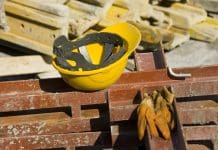Peter Caplehorn, chief executive of the Construction Products Association (CPA), explains the importance of the new Code for Construction Product Information (CCPI) – an initiative developed by the CPA in response to the Hackitt Review, and currently in the process of being set up as an independently-run scheme. Its importance to ensuring a wider industry culture change towards safer buildings should not be underestimated, he argues
Dame Judith Hackitt’s report into Building Regulations and Fire Safety confirmed that radical change was needed for the entire construction industry; this includes construction products, particularly in the areas of testing, information and marketing. It has become abundantly clear from her review and the Inquiry into what went wrong at Grenfell, that the marketing practices of construction product manufacturers need to change.
The CPA has been working hard over the past few years on setting up a new Code for Construction Product Information (CCPI). The Code is the result of an initial Call for Evidence Survey which gathered views from across the construction industry, with some 524 responses gathered in accordance with the Market Research Society Code of Conduct, resulting in 181 pages of free-text responses. This rich and detailed, unprompted data told its own story, with many themes repeated over and over.
Providing clear, accurate, up-to-date, accessible and unambiguous product information
Further workshops were conducted, and engagement sought throughout with the wider supply chain. All feedback from the Call For Evidence survey was carefully considered by the CPA’s Marketing Integrity Group with detailed reviews, consultation and analysis over a two-year period. The result of this work is the Code for Construction Product Information (CCPI). With its eleven Clauses, which cover a wide range of matters from responsibility for product information, to the transparency of performance, proof of stated claims, general information and competency, the Code is designed to ensure manufacturers produce information on their products that is Clear, Accurate, Up-to-date, Accessible and Unambiguous.
A further highly publicised industry consultation took place this year to sense check the Code. It attracted more detailed feedback from 35 Trade Associations and organisations representing the views of over 37,000 provider and user members, as well as a further 180 individual Providers (manufacturers) and Users (installers, architects, consultants, distributors and others) including many of the largest companies. The feedback revealed positive results. Nearly all construction trade bodies who responded (97%) said the Code was very or fairly important for members to comply, with this group also rating all 11 Clauses high for relevance to their members and the sector they represent. Among providers of construction product information, 87% thought it was very or fairly important to their organisation to comply. The majority of respondents – 94% of trade bodies, 93% of providers and 83% of users of information – said the Code met their expectations either completely, almost or in part.
The comprehensive feedback also highlighted a number of valuable suggestions for each Clause, which have been taken on board in order to finalise the Code, and before it is handed over to Construction Product Information Ltd (CPI Ltd) – an independent not-for-profit organisation set up by the Considerate Constructors Scheme to administer and manage the CCPI when it is launched later this year. CPI Ltd. is aiming to launch its new website by the end of July and its task will be to demonstrate how CCPI compliance can add real value to businesses – something the team behind the scheme are already doing.
Sharing common data
To ensure that they minimise the internal cost of compliance for manufacturers, CPI Ltd. is designing its assurance process and tools to share common data across a group of companies, brands and product sets ensuring minimal duplication of data input. They will also be working with industry bodies and trade associations to create a database of regulation, standards, certification, classification, and codes of practices to automate verification of product set compliance as far as possible.
Achieving safer buildings is a hugely complex problem and one that involves many parts of a large jigsaw puzzle falling into place. The provision of Clear, Accurate, Up-to-date, Accessible and Unambiguous product information is one part of that puzzle. But it is not enough on its own. Good product information must go hand-in-hand with competence in the handling of construction products and digitalisation of product information. Only when all these come together can we achieve lasting and tangible results.
Whether construction product information is written in a brochure, a presentation, on a website or said in conversation, it’s crucial that all users of that information have all the facts when making decisions about specifying or installing products. It’s not enough to say that digitalisation of the industry, and the product sector especially, is the solution to all its shortcomings. It’s arguably more important and pressing that the basics are covered off first – clear communication between marketing and technical teams, appropriate processes in place to deal with version control, and a competent person’s sign-off of construction product information. These are all essentials that can be achieved in the very near future, via compliance with the Code.
Achieving wide-spread compliance
If we are to wait for digitalisation alone to provide us with construction product information that is not misrepresented or unclear, we could be waiting years. Digital transformation in industries takes time and construction is still at the start of its journey. We don’t have time to wait. In such time, the risk of another Grenfell remains a more likely concern.
This isn’t to dismiss the importance of digitalisation, and the important work going on in this area to reform the construction products sector. The CPA is leading on a number of initiatives to drive the adoption of digital technologies and processes to make for a smarter industry via the harmonisation and improved accessibility of construction product information. It’s important to state that such innovations for our industry will only be complemented and enhanced by the new CCPI.
The Code is voluntary but there would be encouragement to join and achieve widespread compliance. The alternative could be something devised and imposed by the Government, developed with minimal input and involvement from the industry. The aim is that organisations will insist on only working with Code compliant manufacturers. And we have already heard this intention from a number of businesses, including many of the leading main contractors and specifiers but also key clients, keen to ensure that their contractors are only using products whose performance can be trusted.
We anticipate and hope that this will also include government, and cover all forms of publicly procured construction work. This will ensure that the majority of firms will have to become code-compliant and focus on proper practice in order to remain competitive.
I’d encourage all those interested to visit www.buildingsafely.co.uk, where you can find blogs on the set up of CPI Ltd. as well as the option to be notified when the scheme opens for registrations.
I believe the Code for Construction Product Information will achieve meaningful and permanent change in our industry. The CCPI is one, but nevertheless a crucial part of how we can drive safer building performance and ensure the likes of Grenfell never happen again.














